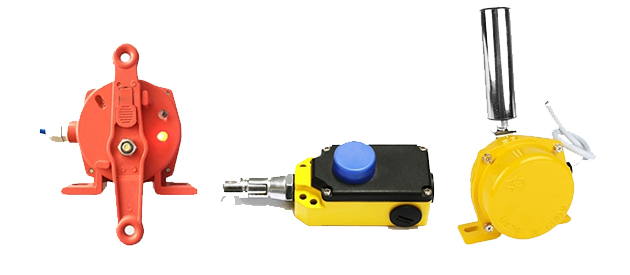Safety Switch vs. Circuit Breaker
Many people may not know the difference between safety switches and circuit breakers. Therefore, the ATO online store has sorted out the differences between the two in this article.
Concept
Safety switch is a switch that prevents people from entering a dangerous area before all safety conditions are met. Also it is a device that monitors current in various applications. Safety switches can be used in major equipment applications (conveyor belts, production line equipment, heavy equipment) and electrical protection of whole system. The safety switch works by monitoring the current and detecting electrical faults, which means that in case of leakage, short circuit, overload, the safety switch will cut off the power supply of the faulty system almost immediately (within a few milliseconds).
Circuit breaker refers to a switching device that can close, carry and break current under normal circuit conditions. Its function is equivalent to the combination of fuse switch and overheating relay. On the other hand, the circuit breaker specially monitors the overload of the circuit. If any particular circuit consumes too much power, the circuit breaker will simply trip, cutting off the power supply. You may be most familiar with this in home applications, such as trying to plug a space heater or blower into an already fully loaded circuit, which can cause a trip.
Working principle
It is often said that safety switch and circuit breaker are interchangeable and serve the same function. However, this is inaccurate. Although both can be found in the electrical control panel, they are different in function and use.Safety switch is a smarter and safer switch.
When the circuit breaker is short circuited, the magnetic field generated by the high current (generally 10-12 times) overcomes the reaction spring, the release pulls the operating mechanism to act, and the switch trips momentarily. When the overload occurs, the current becomes larger, the calorific value intensifies, and the bimetallic sheet deforms to a certain extent to push the mechanism to act (the higher the current is, the shorter the action time is). When a short circuit or serious overload occurs in the circuit, the armature of the over-current release will pull in, it will cause the free tripping mechanism to operate, and the main contact will disconnect the main circuit. When the circuit is under voltage, the armature of the under voltage is released. It also makes the free release mechanism act. The shunt release is used for remote control. In normal operation, its coil is powered off. When distance control is needed, press the start button to power on the coil.
The safety switch can prevent people from entering the dangerous area before all safety conditions are met. When the drive or control system of the machinery and equipment are protected by the safety switch is normally power on, the switch actuator is inserted into the switch body, and the contact is closed. When the switch actuator is pulled out of the switch body, the closed contact in the switch will be disconnected by a mechanical rebound device, thereby stopping the drive or control system of the mechanical equipment. For general safety switches, it is not easy to operate the switch with other common tools such as coins, screwdrivers, knives, etc., except for using special devices (such as special keys, etc.), so the safety switch can avoid the safety problems caused by mistaken operations or malicious operation.
Advantages and disadvantages
1. Circuit breaker
Advantages:
1. After the fault is disconnected, it can be reset manually without replacing the components, unless it needs to be repaired after cutting off the large short-circuit current, so it is an easy-to-reset circuit breaker.
2. It has two sections of protective functions, i.e., the long-time delay release with the inverse-time characteristics and instantaneous current release, which are used as overload and short-circuit protections respectively.
3. Many breakers have intelligent characteristics. Besides protection, they also have functions like electric quantity measurement, fault recording and communication interface to the realize centralized monitoring and management of distribution devices and systems.
Disadvantages
1. It is difficult to realize selective cut-off of upper and lower circuit breakers. When the fault current is relatively high, it is easy to disconnects the upper and lower circuit breakers all of a sudden.
2. The price is relatively higher, the size of it is quite large.
3. Some circuit breakers have low breaking capacity.
2. Safety switch
Advantages:
1. The safety switch is dust-proof and waterproof, with strong shock resistance and long service life. It is suitable for standard mechanical engineering and fields with strict sanitary requirements.
2. The farthest protection distance of pull rope switch can reach 200m, and its service life can reach 2 million times.
3. Safety switch has an optional indicator light and an emergency stop button.
4. The safety switch has diversified dimensions and wiring methods.
 Disadvantages
Disadvantages
1. There are restrictions on the installation conditions of the safety switch, and the temperature should not be too high or too low.
2. It has certain pollution to the environment.
To sum up, the circuit breaker will not hurt people, the circuit breaker will only look for redundant or overload, and will do nothing in the case of short circuit or leakage. This means that if you only rely on circuit breakers, there are still considerable potential hazards. On the other hand, the safety switch will monitor for any inconsistencies in the electrical, and if there is any abnormality, it will turn off the power. In short, circuit breakers protect wiring and safety switches protect personnel and equipment.
ATO.com has emergency stop rope pull switch, pull rope switch, emergency stop switch for belt alignment control, safety interlock switch on sale for your selection.

